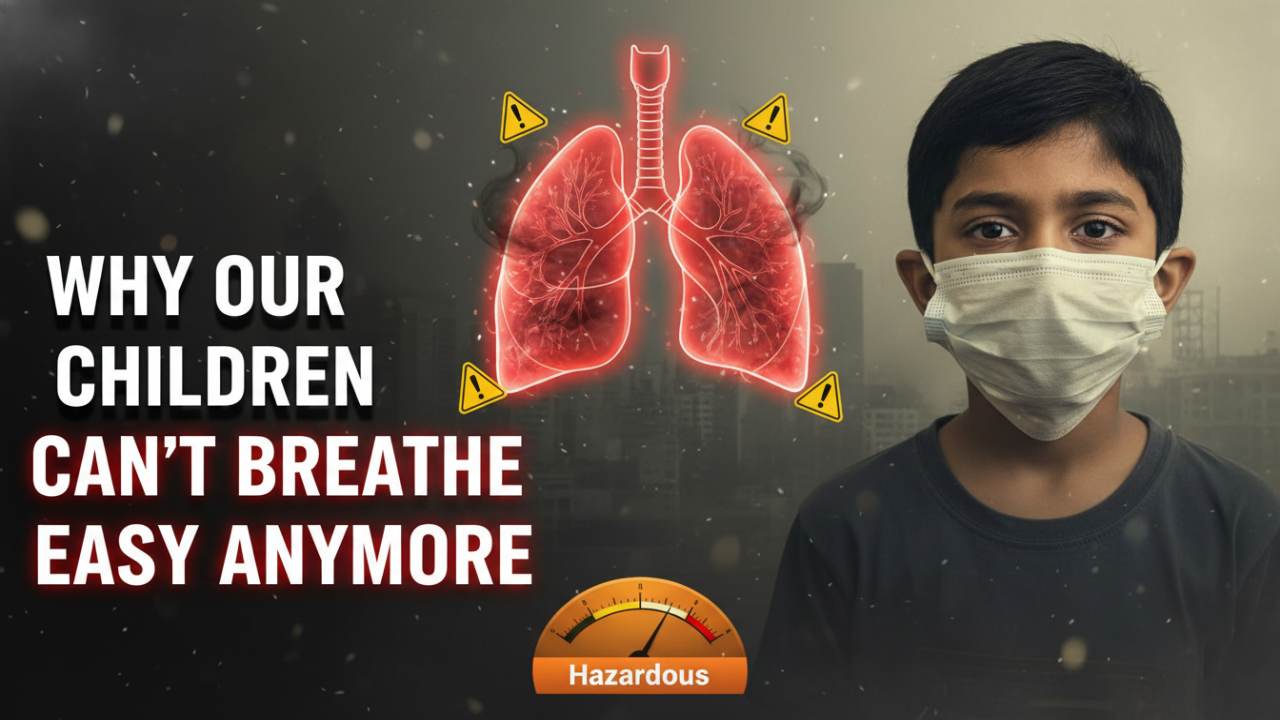The Sunshine Paradox: A Parent's Guide to Vitamin D and Your Child's Growth
Verified By Dr. H. P. Singh | 17-Sep-2025
As a parent, few things are more central to your peace of mind than your child's health and development. You meticulously track their height, celebrate every milestone, and ensure their plate is filled with nutritious food. But what if a crucial, invisible factor was being missed? What if, despite living in a country blessed with abundant sunshine, your child isn't getting enough of the "sunshine vitamin"?
This is the reality for millions in India. We are facing a silent epidemic of Vitamin D deficiency, and our children are particularly vulnerable. This deficiency isn't just about weak bones; it's a critical component that can impact everything from their height and immunity to their mood and overall development.
This comprehensive guide will walk you through what every Indian parent needs to know. We'll explore why this deficiency is so common, how to spot the signs, and most importantly, the practical steps you can take to ensure your child thrives.
Table of Content
Before we dive deeper, let's clarify what Vitamin D is. Unlike other vitamins that we must get from food, Vitamin D is unique. It’s actually a prohormone that our bodies produce when our skin is exposed to sunlight—specifically, ultraviolet B (UVB) rays. When these rays hit the skin, they trigger a chemical reaction that starts the production of Vitamin D.
While we can get small amounts from certain foods, sunlight remains our primary and most efficient source. This is why it’s famously nicknamed the "sunshine vitamin." It acts as a key that unlocks the body's potential to use other crucial minerals, making it a foundational element for health.
A child’s growing body is like a construction site, and calcium is the primary building block for a strong skeletal structure. However, Vitamin D is the master foreman of this site.
- Bone Development: The most well-known role of Vitamin D is to regulate calcium and phosphate absorption in the gut. Without enough Vitamin D, the body cannot effectively absorb calcium from food, no matter how much milk or paneer your child consumes. This calcium is essential for building strong, dense bones during the peak growth years of childhood and adolescence. A severe deficiency can lead to soft, weak, and deformed bones, a condition known as rickets.
- Immune System Support: Do you feel like your child is constantly catching colds and infections? Vitamin D deficiency could be a contributing factor. It plays a vital role in modulating our immune system, helping our bodies fight off viruses and bacteria effectively. Adequate levels can mean fewer sick days from school.
- Muscle Function: Strong bones need strong muscles to support them. Vitamin D is also essential for muscle development and function. Children with low levels may experience muscle weakness or aches, which can affect their physical activity and coordination.
Also read: What is Paracetamol, and why is it commonly given to Children
It seems counterintuitive that a country like India, with its ample sunlight, would have such high rates of Vitamin D deficiency. Several factors contribute to this surprising public health issue:
- Skin Tone: Melanin, the pigment that gives skin its colour, is a natural sunblock. While it protects the skin from sun damage, it also reduces the skin's ability to produce Vitamin D from sunlight. People with darker skin tones need a lot more sun exposure compared to those with lighter skin to produce the same amount of Vitamin D.
- Modern Lifestyles: The way we live has changed. Children spend more time indoors than ever before—in classrooms, in front of screens, or in homes. The traditional outdoor playtime has been largely replaced by indoor activities, drastically cutting down their sun exposure.
- Urban Pollution: Thick smog and air pollution in many Indian cities can act as a filter, blocking the UVB rays from the sun from reaching the ground, further hindering Vitamin D synthesis.
- Dietary Habits: The typical Indian diet, especially a vegetarian one, is not naturally rich in Vitamin D. The primary food sources are fatty fish (like salmon and mackerel), cod liver oil, and egg yolks, which may not be a regular part of many children's diets. While fortified foods are becoming available, they are not yet universally consumed.
Vitamin D deficiency can be subtle, and its symptoms can be easily mistaken for other common childhood issues. Be watchful for these signs:
- Delayed Growth: If your child is not meeting their growth milestones or is noticeably shorter than their peers, it's worth investigating.
- Bone and Muscle Pain: Your child might complain of aches in their legs, a feeling of heaviness, or general muscle weakness. This is often dismissed as "growing pains."
- Frequent Illnesses: A weakened immune system can lead to recurring respiratory infections and other illnesses.
- Delayed Teething: Vitamin D is crucial for dental health, and a deficiency can delay the eruption of teeth in infants.
- Irritability and Mood Changes: While harder to pinpoint, some studies have linked low Vitamin D levels to mood swings and irritability in children.
- Bone Deformities: In severe cases (rickets), you might notice bowed legs, a curved spine, or a thickened appearance at the wrists and ankles.
If you suspect your child might be deficient, it is crucial not to self-diagnose or start giving them high-dose supplements. The best way to find out for certain is with a straightforward blood test.
We spoke with Dr. H. P. Singh, Sr. Consultant Pediatrician at Kailash Hospital, who emphasizes a cautious and professional approach. "We are seeing a significant rise in Vitamin D deficiency even in toddlers," says Dr. Singh. "Parents might notice their child is more lethargic or complains of leg pain. It’s vital not to ignore these signs. A blood test can give us a clear picture. Based on the results, we can prescribe the correct dosage of Vitamin D supplements. Over-the-counter supplementation without a doctor's guidance can be ineffective or even harmful, so a consultation is always the first and most important step."
Also read: Is Your Child Suffering from Diarrhea? Avoid These Common Parenting Mistakes
The good news is that Vitamin D deficiency is both preventable and treatable. Here’s a three-pronged approach you can adopt:
1. Smart and Safe Sun Exposure
This is the most natural and effective method.
- Timing is Key: The best time for Vitamin D synthesis is between 11 AM and 3 PM when the sun's UVB rays are strongest. However, this is also the time for the highest risk of sunburn. A safer approach for children is to aim for 20-30 minutes of sun exposure during the mid-morning (around 10-11 AM) or late afternoon (3-4 PM).
- Expose More Skin: For the body to produce enough Vitamin D, a significant area of skin needs to be exposed. Having your child play outdoors in shorts and a t-shirt (or with arms and legs uncovered) is ideal. Sunscreen blocks UVB rays, so this time should be without sunscreen.
- Be Sun-Smart: Never let your child's skin burn. The goal is moderate, regular exposure, not prolonged sunbathing.
2. Focus on Vitamin D-Rich and Fortified Foods
While food alone is rarely enough to correct a deficiency, it plays a supportive role.
- Natural Sources: Include egg yolks, mushrooms (especially those exposed to sunlight), and fatty fish like salmon or tuna in your child's diet if your family eats them.
- Fortified Foods: This is a game-changer. Look for products that are "fortified with Vitamin D." This includes:
- Fortified Milk
- Fortified Yogurt and Lassi
- Fortified Breakfast Cereals
- Fortified Fruit Juices
- Fortified Infant Formula
3. Follow Your Doctor’s Advice on Supplements
If your child is diagnosed with a deficiency, your paediatrician will recommend a supplement.
- Dosage is Crucial: The doctor will prescribe a specific dosage based on your child's age, weight, and deficiency level. This might be a daily dose or a higher weekly dose.
- Consistency Matters: Ensure your child takes the supplement as prescribed. They are available as drops for infants, and as chewable tablets or gummies for older children.
Ensuring your child has adequate Vitamin D is one of the most fundamental investments you can make in their long-term health. It is the invisible foundation upon which their strong bones, robust immune system, and healthy growth are built. By understanding the risks, recognizing the signs, and taking proactive steps with smart sun exposure, a supportive diet, and professional medical advice, you can solve the "sunshine paradox" for your family.
If you have any concerns about your child’s growth or well-being, don't hesitate. A simple conversation with your paediatrician today can set them on the path to a healthier, stronger tomorrow.



 +91-9711918451
+91-9711918451
 international.marketing@kailashhealthcare.com
international.marketing@kailashhealthcare.com







